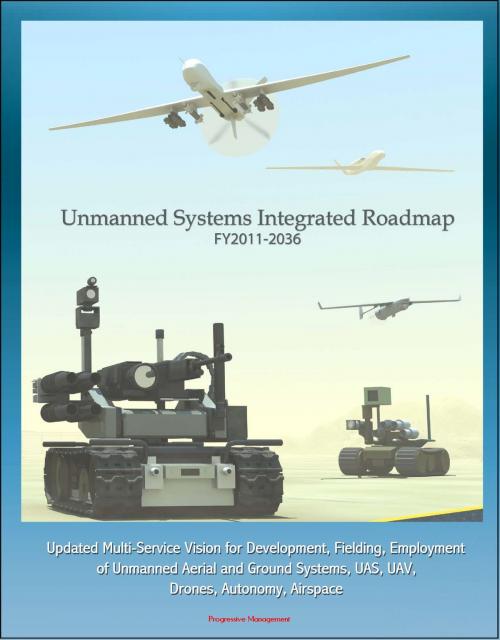Unmanned Systems Integrated Roadmap FY 2011-2036: Updated Multi-Service Vision for Development, Fielding, Employment of Unmanned Aerial and Ground Systems, UAS, UAV, Drones, Autonomy, Airspace
Nonfiction, Science & Nature, Technology, Aeronautics & Astronautics, History, Military, Aviation| Author: | Progressive Management | ISBN: | 9781301129362 |
| Publisher: | Progressive Management | Publication: | September 18, 2012 |
| Imprint: | Smashwords Edition | Language: | English |
| Author: | Progressive Management |
| ISBN: | 9781301129362 |
| Publisher: | Progressive Management |
| Publication: | September 18, 2012 |
| Imprint: | Smashwords Edition |
| Language: | English |
This document provides a DoD vision for the continuing development, fielding, and employment of unmanned systems technologies. Since publication of the last DoD Roadmap in 2009, the military Services have released individual Service roadmaps or related strategy documents. This roadmap defines a common vision, establishes the current state of unmanned systems in today's force, and outlines a strategy for the common challenges that must be addressed to achieve the shared vision.
U.S. and allied combat operations continue to highlight the value of unmanned systems in the modern combat environment. Combatant Commanders (CCDRs) and warfighters value the inherent features of unmanned systems, especially their persistence, versatility, and reduced risk to human life. The U.S. military Services are fielding these systems in rapidly increasing numbers across all domains: air, ground, and maritime. Unmanned systems provide diverse capabilities to the joint commander to conduct operations across the range of military operations: environmental sensing and battlespace awareness; chemical, biological, radiological, and nuclear (CBRN) detection; counter-improvised explosive device (C-IED) capabilities; port security; precision targeting; and precision strike. Furthermore, the capabilities provided by these unmanned systems continue to expand.
The Department of Defense (DoD) has been successful in rapidly developing and fielding unmanned systems. DoD will continue to focus on responding rapidly to CCDR requirements, while ensuring systems are acquired within the framework of DoD's new wide-ranging Efficiencies Initiatives1. In the fiscal environment facing the Nation, DoD, in concert with industry, must pursue investments and business practices that drive down life-cycle costs for unmanned systems. Affordability will be treated as a key performance parameter (KPP) equal to, if not more important than, schedule and technical performance. DoD will partner with industry to continue to invest in unmanned systems technologies while providing incentives for industry to implement cost-saving measures and rewarding industry members that routinely demonstrate exemplary performance.
CONTENTS * CHAPTER 1 * INTRODUCTION/SCOPE * 1.1 Purpose * 1.2 Scope * CHAPTER 2 * VISION * 2.1 Future Operational Environment * 2.2 DoD's Vision * 2.3 Vignettes * CHAPTER 3 * CURRENT STATE * 3.1 Requirements Development and Systems Acquisition * 3.2 Unmanned Systems Applied to Joint Capability Areas * 3.3 Unmanned Aircraft Systems (UAS) * 3.4 Unmanned Ground Systems (UGS) * 3.5 Unmanned Maritime Systems (UMS) * 3.6 Challenges for Unmanned Systems * CHAPTER 4 * INTEROPERABILITY * 4.1 Overview * 4.2 Functional Description * 4.3 Today's State * 4.4 Problem Statement * 4.5 The Way Ahead * 4.6 Summary * CHAPTER 5 * AUTONOMY * 5.1 Functional Description * 5.2 Today's State * 5.3 Problem Statement * 5.4 Way Ahead * 5.5 Summary * CHAPTER 6 * AIRSPACE INTEGRATION (AI) * 6.1 Functional Description * 6.2 Today's State * 6.3 Problem Statement * 6.4 Way Ahead * 6.5 Summary * CHAPTER 7 * COMMUNICATIONS * 7.1 Functional Description * 7.2 Today's State * 7.3 Problem Statement * 7.4 Way Ahead * 7.5 Future Trends * 7.6 Summary * CHAPTER 8 * TRAINING * 8.1 Functional Description * 8.2 Today's State * 8.3 Problem Statement * 8.4 Way Ahead * CHAPTER 9 * PROPULSION AND POWER * 9.1 Functional Description * 9.2 Today's State * 9.3 Problem Statement * 9.4 Way Ahead * CHAPTER 10 * MANNED-UNMANNED (MUM) TEAMING * 10.1 Functional Description * 10.2 Today's State * 10.3 Problem Statement * 10.4 Way Ahead (2011-2036) * CHAPTER 11 * SUMMARY * FOOTNOTES * APPENDIX A: REFERENCES * APPENDIX B: ABBREVIATIONS * APPENDIX C: GLOSSARY
This document provides a DoD vision for the continuing development, fielding, and employment of unmanned systems technologies. Since publication of the last DoD Roadmap in 2009, the military Services have released individual Service roadmaps or related strategy documents. This roadmap defines a common vision, establishes the current state of unmanned systems in today's force, and outlines a strategy for the common challenges that must be addressed to achieve the shared vision.
U.S. and allied combat operations continue to highlight the value of unmanned systems in the modern combat environment. Combatant Commanders (CCDRs) and warfighters value the inherent features of unmanned systems, especially their persistence, versatility, and reduced risk to human life. The U.S. military Services are fielding these systems in rapidly increasing numbers across all domains: air, ground, and maritime. Unmanned systems provide diverse capabilities to the joint commander to conduct operations across the range of military operations: environmental sensing and battlespace awareness; chemical, biological, radiological, and nuclear (CBRN) detection; counter-improvised explosive device (C-IED) capabilities; port security; precision targeting; and precision strike. Furthermore, the capabilities provided by these unmanned systems continue to expand.
The Department of Defense (DoD) has been successful in rapidly developing and fielding unmanned systems. DoD will continue to focus on responding rapidly to CCDR requirements, while ensuring systems are acquired within the framework of DoD's new wide-ranging Efficiencies Initiatives1. In the fiscal environment facing the Nation, DoD, in concert with industry, must pursue investments and business practices that drive down life-cycle costs for unmanned systems. Affordability will be treated as a key performance parameter (KPP) equal to, if not more important than, schedule and technical performance. DoD will partner with industry to continue to invest in unmanned systems technologies while providing incentives for industry to implement cost-saving measures and rewarding industry members that routinely demonstrate exemplary performance.
CONTENTS * CHAPTER 1 * INTRODUCTION/SCOPE * 1.1 Purpose * 1.2 Scope * CHAPTER 2 * VISION * 2.1 Future Operational Environment * 2.2 DoD's Vision * 2.3 Vignettes * CHAPTER 3 * CURRENT STATE * 3.1 Requirements Development and Systems Acquisition * 3.2 Unmanned Systems Applied to Joint Capability Areas * 3.3 Unmanned Aircraft Systems (UAS) * 3.4 Unmanned Ground Systems (UGS) * 3.5 Unmanned Maritime Systems (UMS) * 3.6 Challenges for Unmanned Systems * CHAPTER 4 * INTEROPERABILITY * 4.1 Overview * 4.2 Functional Description * 4.3 Today's State * 4.4 Problem Statement * 4.5 The Way Ahead * 4.6 Summary * CHAPTER 5 * AUTONOMY * 5.1 Functional Description * 5.2 Today's State * 5.3 Problem Statement * 5.4 Way Ahead * 5.5 Summary * CHAPTER 6 * AIRSPACE INTEGRATION (AI) * 6.1 Functional Description * 6.2 Today's State * 6.3 Problem Statement * 6.4 Way Ahead * 6.5 Summary * CHAPTER 7 * COMMUNICATIONS * 7.1 Functional Description * 7.2 Today's State * 7.3 Problem Statement * 7.4 Way Ahead * 7.5 Future Trends * 7.6 Summary * CHAPTER 8 * TRAINING * 8.1 Functional Description * 8.2 Today's State * 8.3 Problem Statement * 8.4 Way Ahead * CHAPTER 9 * PROPULSION AND POWER * 9.1 Functional Description * 9.2 Today's State * 9.3 Problem Statement * 9.4 Way Ahead * CHAPTER 10 * MANNED-UNMANNED (MUM) TEAMING * 10.1 Functional Description * 10.2 Today's State * 10.3 Problem Statement * 10.4 Way Ahead (2011-2036) * CHAPTER 11 * SUMMARY * FOOTNOTES * APPENDIX A: REFERENCES * APPENDIX B: ABBREVIATIONS * APPENDIX C: GLOSSARY















